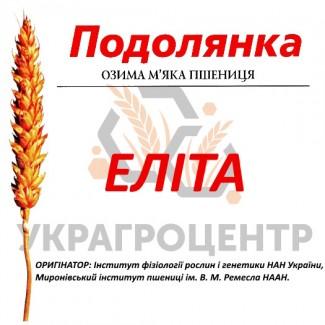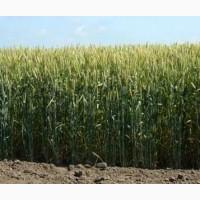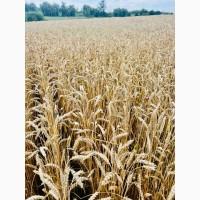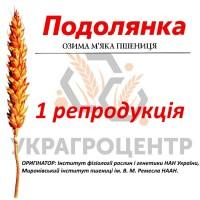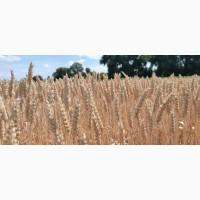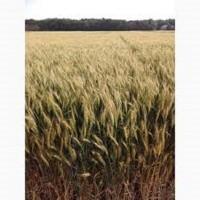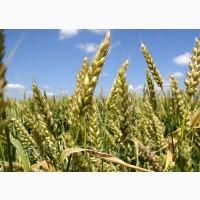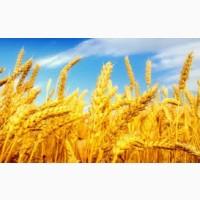For sale / buy
Winter wheat seeds PODOLYANKA elite 2024, Poltava region.
Price12,500 UAH. / ton
Region:all of Ukraine,
Poltava region.
(Chutovo)
Updated:
Purpose of grain: Seed material
Quantity: 100 tons
Podolyanka (bezosta)
winter soft wheat
ORIGINATOR: Institute of Plant Physiology and Genetics of the National Academy of Sciences of Ukraine, Myroniv Wheat Institute named after V. M. Remesla of the National Academy of Sciences of Ukraine,
Entered into the Register of Plant Varieties of Ukraine for 2003 for cultivation in the steppe, forest-steppe and steppe zones of Ukraine under rain and irrigation.
BIOLOGICAL CHARACTERISTICS: medium-stem variety, intensive type, medium-ripening. It has high winter and drought resistance, resistance tograin shedding even during rest, moderately resistant to lodging and damage by powdery mildew, brown leaf rust, and root rot. A variety of lutescens.
GRAIN QUALITY: flour milling and baking properties are excellent.Grain Podolyanki contains 13.5-14.7% protein, 28.7-31.5% raw gluten, flour strength 320-410 a. o., the volume of bread from 100 g of flour is 1100-1210 ml, the overall assessment of bread-making properties is 4.2-5.0 points. Classified as strong wheat. With proper agricultural techniques, the genetics of the variety ensures the production of high-quality grain.
ECONOMIC CHARACTERISTICS: the main feature of the variety is very high production reliability. The variety is maximally adapted to arid growing conditions, highly productive, intensive type of use. Ensures obtaining high and stable harvests over the years on different backgrounds of mineral nutrition. Undemanding to growing conditions, predecessors and sowing dates, has high ecological plasticity. The Podolyanka variety, as it is less picky about growing conditions, also has significant advantages over other varieties in terms of average and satisfactory predecessors and on average and poor agrobackgrounds.
It is characterized by a good regenerative capacity, an intensive start of regrowth and a rapid increase in vegetative mass, endurance to spring colds, has a high bushiness, a thick stem, suppresses weeds well.
According to the originator (IFRG of the National Academy of Sciences of Ukraine) in the years of the competitive trial, the average yield of Podolyanka was 66.7 t/ha, which exceeded the yield of the national standard by 8.2 t/ha. According to the specifications of the Kirovohrad State Variety Testing Station, the yield of the variety for two predecessors was 88.6 and 86.5 t/ha, which is 6.5-14.1 t/ha more than the national standard Albatros Odesa.
The grain yield in the State Variety Study in 52 variety trials was 60.0-96.0 t/ha. Substantial yield increases of the Podolyanka variety to the national standard — 5.0-19.3 t/ha were obtained in 57 variety experiments, including increases of 10.0-19.3 t/ha — in 27 variety studies, 23 regions of Ukraine, covering the Steppe, Forest-Steppe and Polissia zones (Donetsk, Odesa, Kirovohrad, Dnipropetrovsk, Kherson, Mykolaiv, Zaporizhzhia, Luhansk, Vinnytsia, Poltava, Cherkasy , Sumy, Volyn, Kharkiv, Kyiv, Zhytomyr, Chernihiv, Rivne, Ternopil, Lviv, Zakarpattia, Ivano-Frankivsk, Chernivtsi).(//tractor-service.com)
The maximum yields of the variety are 100.7; 102.2 and 113.7 t/ha were obtained in production crops of OJSC Shamrayivske (Ruda Skvyrsky district, Kyiv region). High yields of the variety were obtained in production crops of the Ternopil state expert center; Kyiv region (Glevakh village of Vasylkiv district); 75.3 in the Kirovohrad region (Novoselytsia village, Ulyanovsk district) and in Hungary (Martonvashar town), respectively; 82.8; 94.8 and 96.0 t/ha.
In 2003, against the backdrop of the mass death of winter crops in Ukraine, Podolyanka produced a record harvest of 78.0 t/ha on an area of 80 ha and 66.5 t/ha on an area of 560 ha (SSG Pyatidny Volodymyr-Volynsky district, Volyn region) . A high yield of 70.3 t/ha was obtained in the Czech Republic, which exceeded the local standard by 27.0 t/ha, which was partially frozen. In the village In Novoselytsa, Ulyanovsk district, Kirovohrad region, all production crops of 10 varieties died, only Podolyanka survived.
In 2004, high yields of the variety were obtained at LLC NVA Perlyna Podillia of the Khmelnytsky region — 97.5 and 93.0 t/ha; OJSC Shamrayvske (Ruda village, Skvyrsky district, Kyiv region) — 96.0 t/ha; in the trials of the Center for Variety Science and Variety Study (Kyiv Region) — 90.5 and 88.6 t/ha; NDC Southern Kirovohrad region 85.4 and 96.0 t/ha; Ternopil state expert center 82.4 t/ha and in the Czech Republic 99.4 t/ha.
In recent years, the yield of the variety in the research farm of the Institute was 75.2-109.0 t/ha.
AGROTECHNICAL REQUIREMENTS: the variety must be grown using intensive technology with the introduction of optimal doses of mineral fertilizers. On high backgrounds of mineral nutrition, to prevent lodging, it is necessary to apply retardants. To ensure high grain yields, it is also necessary to protect plants from pests and diseases, especially after throwing out the ear, with fungicides such as Alto Super, Falcon or Folicur.
In order to obtain high-quality grain, it is necessary to carry out the third top dressing with dry nitrogen fertilizers or foliar top dressing with urea N10-15 kg per ha in the stage of earing — milk ripeness.
The seed sowing rate is 4.5-5.5 million similar grains per 1 ha, depending on the zone, moisture supply, predecessor and sowing dates.
→ for allseeds are provided certificates for variety and seed quality
→ seed packaging: elite – bags of 50 kg, reproduction – big-bags of 1 t (or by agreement)
→ the prices are indicated on the basis of 100% prepayment, franked - the seller's warehouse (Kolomak, Kharkiv region)
→ the seeds are grown under the control of the company's specialists and the author's supervision of the originators
winter soft wheat
ORIGINATOR: Institute of Plant Physiology and Genetics of the National Academy of Sciences of Ukraine, Myroniv Wheat Institute named after V. M. Remesla of the National Academy of Sciences of Ukraine,
Entered into the Register of Plant Varieties of Ukraine for 2003 for cultivation in the steppe, forest-steppe and steppe zones of Ukraine under rain and irrigation.
BIOLOGICAL CHARACTERISTICS: medium-stem variety, intensive type, medium-ripening. It has high winter and drought resistance, resistance tograin shedding even during rest, moderately resistant to lodging and damage by powdery mildew, brown leaf rust, and root rot. A variety of lutescens.
GRAIN QUALITY: flour milling and baking properties are excellent.Grain Podolyanki contains 13.5-14.7% protein, 28.7-31.5% raw gluten, flour strength 320-410 a. o., the volume of bread from 100 g of flour is 1100-1210 ml, the overall assessment of bread-making properties is 4.2-5.0 points. Classified as strong wheat. With proper agricultural techniques, the genetics of the variety ensures the production of high-quality grain.
ECONOMIC CHARACTERISTICS: the main feature of the variety is very high production reliability. The variety is maximally adapted to arid growing conditions, highly productive, intensive type of use. Ensures obtaining high and stable harvests over the years on different backgrounds of mineral nutrition. Undemanding to growing conditions, predecessors and sowing dates, has high ecological plasticity. The Podolyanka variety, as it is less picky about growing conditions, also has significant advantages over other varieties in terms of average and satisfactory predecessors and on average and poor agrobackgrounds.
It is characterized by a good regenerative capacity, an intensive start of regrowth and a rapid increase in vegetative mass, endurance to spring colds, has a high bushiness, a thick stem, suppresses weeds well.
According to the originator (IFRG of the National Academy of Sciences of Ukraine) in the years of the competitive trial, the average yield of Podolyanka was 66.7 t/ha, which exceeded the yield of the national standard by 8.2 t/ha. According to the specifications of the Kirovohrad State Variety Testing Station, the yield of the variety for two predecessors was 88.6 and 86.5 t/ha, which is 6.5-14.1 t/ha more than the national standard Albatros Odesa.
The grain yield in the State Variety Study in 52 variety trials was 60.0-96.0 t/ha. Substantial yield increases of the Podolyanka variety to the national standard — 5.0-19.3 t/ha were obtained in 57 variety experiments, including increases of 10.0-19.3 t/ha — in 27 variety studies, 23 regions of Ukraine, covering the Steppe, Forest-Steppe and Polissia zones (Donetsk, Odesa, Kirovohrad, Dnipropetrovsk, Kherson, Mykolaiv, Zaporizhzhia, Luhansk, Vinnytsia, Poltava, Cherkasy , Sumy, Volyn, Kharkiv, Kyiv, Zhytomyr, Chernihiv, Rivne, Ternopil, Lviv, Zakarpattia, Ivano-Frankivsk, Chernivtsi).(//tractor-service.com)
The maximum yields of the variety are 100.7; 102.2 and 113.7 t/ha were obtained in production crops of OJSC Shamrayivske (Ruda Skvyrsky district, Kyiv region). High yields of the variety were obtained in production crops of the Ternopil state expert center; Kyiv region (Glevakh village of Vasylkiv district); 75.3 in the Kirovohrad region (Novoselytsia village, Ulyanovsk district) and in Hungary (Martonvashar town), respectively; 82.8; 94.8 and 96.0 t/ha.
In 2003, against the backdrop of the mass death of winter crops in Ukraine, Podolyanka produced a record harvest of 78.0 t/ha on an area of 80 ha and 66.5 t/ha on an area of 560 ha (SSG Pyatidny Volodymyr-Volynsky district, Volyn region) . A high yield of 70.3 t/ha was obtained in the Czech Republic, which exceeded the local standard by 27.0 t/ha, which was partially frozen. In the village In Novoselytsa, Ulyanovsk district, Kirovohrad region, all production crops of 10 varieties died, only Podolyanka survived.
In 2004, high yields of the variety were obtained at LLC NVA Perlyna Podillia of the Khmelnytsky region — 97.5 and 93.0 t/ha; OJSC Shamrayvske (Ruda village, Skvyrsky district, Kyiv region) — 96.0 t/ha; in the trials of the Center for Variety Science and Variety Study (Kyiv Region) — 90.5 and 88.6 t/ha; NDC Southern Kirovohrad region 85.4 and 96.0 t/ha; Ternopil state expert center 82.4 t/ha and in the Czech Republic 99.4 t/ha.
In recent years, the yield of the variety in the research farm of the Institute was 75.2-109.0 t/ha.
AGROTECHNICAL REQUIREMENTS: the variety must be grown using intensive technology with the introduction of optimal doses of mineral fertilizers. On high backgrounds of mineral nutrition, to prevent lodging, it is necessary to apply retardants. To ensure high grain yields, it is also necessary to protect plants from pests and diseases, especially after throwing out the ear, with fungicides such as Alto Super, Falcon or Folicur.
In order to obtain high-quality grain, it is necessary to carry out the third top dressing with dry nitrogen fertilizers or foliar top dressing with urea N10-15 kg per ha in the stage of earing — milk ripeness.
The seed sowing rate is 4.5-5.5 million similar grains per 1 ha, depending on the zone, moisture supply, predecessor and sowing dates.
→ for allseeds are provided certificates for variety and seed quality
→ seed packaging: elite – bags of 50 kg, reproduction – big-bags of 1 t (or by agreement)
→ the prices are indicated on the basis of 100% prepayment, franked - the seller's warehouse (Kolomak, Kharkiv region)
→ the seeds are grown under the control of the company's specialists and the author's supervision of the originators
|
Author, contacts | |
Ihor / отзывы, инфо. / activity evaluation | |
|
Phone:
(050xxxxxx
show|| |209
| |
Ad ID: #1202737
(added by a registered user, registration date: 07-21-2022)
Added/ Updated: 09-17-2024 10:27 (relevant, until: 09-17-2025)
Permanent ad address:
Showed / watched for today: ?, total: ?
Similar ads
Among them there are many interesting...
